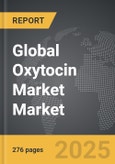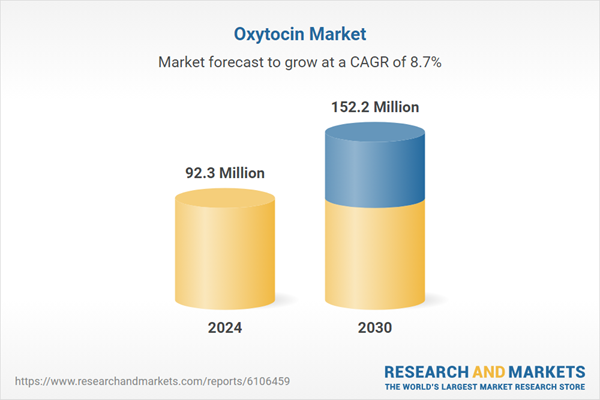Global Oxytocin Market - Key Trends & Drivers Summarized
Why Is Oxytocin a Vital Drug in Maternal Healthcare and Beyond?
Oxytocin is a peptide hormone used extensively in obstetric care to induce labor, prevent and treat postpartum hemorrhage, and assist in uterine contraction during and after childbirth. It plays a critical role in maternal healthcare, particularly in reducing mortality from postpartum bleeding - a leading cause of maternal death in low-resource settings. The drug is included in the WHO's list of essential medicines due to its significance in improving birth outcomes.Pharmaceutical-grade oxytocin is typically administered via injection, requiring cold-chain storage to maintain stability. Its usage is most common in hospitals, maternity clinics, and rural health centers with skilled birth attendants. While primarily known for its uterotonic effects, oxytocin has also been investigated for potential applications in behavioral science, including studies on social bonding, stress regulation, and autism spectrum disorders. However, such applications remain exploratory and not yet standard clinical practice.
How Is Formulation, Distribution, and Storage Evolving to Improve Access and Efficacy?
Standard oxytocin formulations include injectable solutions that must be stored between 2°C and 8°C to retain potency. This requirement poses challenges in rural or under-resourced regions lacking reliable refrigeration. As a result, there is increasing interest in heat-stable formulations and alternatives such as oxytocin analogs or sublingual options that reduce cold-chain dependency.Efforts to improve access include innovations in unit-dose prefilled syringes and auto-disable delivery devices that minimize dosing errors and contamination. New packaging designs are enhancing usability in field settings, while collaborative global initiatives aim to expand supply chain resilience, particularly in sub-Saharan Africa and parts of Asia where maternal mortality remains high. Regulatory frameworks are also being strengthened to ensure the quality of oxytocin products, as substandard formulations have posed safety risks in certain markets.
Where Is Oxytocin Most Widely Used and Which Stakeholders Are Driving Distribution?
Oxytocin sees its highest clinical use in labor wards of hospitals, maternity clinics, and emergency obstetric care centers. Public health systems and non-governmental organizations are key facilitators of distribution, particularly in regions where maternal health programs are supported by international aid. National health ministries often include oxytocin in maternal care kits as part of standard delivery protocols.Regional demand is highest in developing countries, where maternal mortality reduction is a public health priority. However, inconsistencies in product quality, storage conditions, and healthcare worker training still limit optimal usage. In more developed healthcare systems, oxytocin use is widespread and regulated, with consistent access across birthing facilities. Pharmaceutical companies, health ministries, and donor-funded health programs remain central players in procurement and distribution strategies.
Growth in the Oxytocin market is driven by several factors…
Growth in the oxytocin market is driven by factors such as increasing global emphasis on maternal health, expanded investment in emergency obstetric care, and rising birth rates in regions with limited access to surgical interventions. Efforts to reduce postpartum hemorrhage, including updated clinical guidelines and expanded midwife training, are reinforcing oxytocin's role in frontline childbirth care.Demand is further supported by development of heat-stable formulations that improve access in low-resource settings. Procurement programs backed by international health organizations are scaling up supply and quality assurance mechanisms. Regulatory reforms to eliminate substandard products, combined with broader inclusion of oxytocin in national health protocols, continue to support market growth globally.
Report Scope
The report analyzes the Oxytocin market, presented in terms of market value (US$). The analysis covers the key segments and geographic regions outlined below:- Segments: Indication (Antepartum, Postpartum); Distribution Channel (Hospital Pharmacies, Drug Stores Distribution Channel, Online Distribution Channel).
- Geographic Regions/Countries: World; United States; Canada; Japan; China; Europe (France; Germany; Italy; United Kingdom; Spain; Russia; and Rest of Europe); Asia-Pacific (Australia; India; South Korea; and Rest of Asia-Pacific); Latin America (Argentina; Brazil; Mexico; and Rest of Latin America); Middle East (Iran; Israel; Saudi Arabia; United Arab Emirates; and Rest of Middle East); and Africa.
Key Insights:
- Market Growth: Understand the significant growth trajectory of the Antepartum Indication segment, which is expected to reach US$108.3 Million by 2030 with a CAGR of a 10%. The Postpartum Indication segment is also set to grow at 5.8% CAGR over the analysis period.
- Regional Analysis: Gain insights into the U.S. market, valued at $25.2 Million in 2024, and China, forecasted to grow at an impressive 13.7% CAGR to reach $33.6 Million by 2030. Discover growth trends in other key regions, including Japan, Canada, Germany, and the Asia-Pacific.
Why You Should Buy This Report:
- Detailed Market Analysis: Access a thorough analysis of the Global Oxytocin Market, covering all major geographic regions and market segments.
- Competitive Insights: Get an overview of the competitive landscape, including the market presence of major players across different geographies.
- Future Trends and Drivers: Understand the key trends and drivers shaping the future of the Global Oxytocin Market.
- Actionable Insights: Benefit from actionable insights that can help you identify new revenue opportunities and make strategic business decisions.
Key Questions Answered:
- How is the Global Oxytocin Market expected to evolve by 2030?
- What are the main drivers and restraints affecting the market?
- Which market segments will grow the most over the forecast period?
- How will market shares for different regions and segments change by 2030?
- Who are the leading players in the market, and what are their prospects?
Report Features:
- Comprehensive Market Data: Independent analysis of annual sales and market forecasts in US$ Million from 2024 to 2030.
- In-Depth Regional Analysis: Detailed insights into key markets, including the U.S., China, Japan, Canada, Europe, Asia-Pacific, Latin America, Middle East, and Africa.
- Company Profiles: Coverage of players such as Air Liquide, Air Products and Chemicals, Inc., Alstom Power, Amec Foster Wheeler (Now part of Wood Group), ANDRITZ Group and more.
- Complimentary Updates: Receive free report updates for one year to keep you informed of the latest market developments.
Some of the 42 companies featured in this Oxytocin market report include:
- Alembic Pharmaceuticals Ltd.
- Amneal Pharmaceuticals, Inc.
- Bayer AG
- BioPharma Laboratories
- Cipla Limited
- Endo International plc
- Fresenius Kabi
- GlaxoSmithKline plc (GSK)
- Halewood Laboratories Pvt. Ltd.
- Hikma Pharmaceuticals plc
- Intas Pharmaceuticals Ltd.
- Mylan N.V. (Now part of Viatris)
- Novartis AG
- Pfizer Inc.
- ProSpec-Tany Technogene Ltd.
- Rusan Pharma Ltd.
- Sandoz (a Novartis division)
- Shanghai Cisen Pharmaceutical Co.
- Sun Pharmaceutical Industries Ltd.
- Teva Pharmaceutical Industries Ltd.
This edition integrates the latest global trade and economic shifts into comprehensive market analysis. Key updates include:
- Tariff and Trade Impact: Insights into global tariff negotiations across 180+ countries, with analysis of supply chain turbulence, sourcing disruptions, and geographic realignment. Special focus on 2025 as a pivotal year for trade tensions, including updated perspectives on the Trump-era tariffs.
- Adjusted Forecasts and Analytics: Revised global and regional market forecasts through 2030, incorporating tariff effects, economic uncertainty, and structural changes in globalization. Includes historical analysis from 2015 to 2023.
- Strategic Market Dynamics: Evaluation of revised market prospects, regional outlooks, and key economic indicators such as population and urbanization trends.
- Innovation & Technology Trends: Latest developments in product and process innovation, emerging technologies, and key industry drivers shaping the competitive landscape.
- Competitive Intelligence: Updated global market share estimates for 2025, competitive positioning of major players (Strong/Active/Niche/Trivial), and refined focus on leading global brands and core players.
- Expert Insight & Commentary: Strategic analysis from economists, trade experts, and domain specialists to contextualize market shifts and identify emerging opportunities.
Table of Contents
Companies Mentioned (Partial List)
A selection of companies mentioned in this report includes, but is not limited to:
- Alembic Pharmaceuticals Ltd.
- Amneal Pharmaceuticals, Inc.
- Bayer AG
- BioPharma Laboratories
- Cipla Limited
- Endo International plc
- Fresenius Kabi
- GlaxoSmithKline plc (GSK)
- Halewood Laboratories Pvt. Ltd.
- Hikma Pharmaceuticals plc
- Intas Pharmaceuticals Ltd.
- Mylan N.V. (Now part of Viatris)
- Novartis AG
- Pfizer Inc.
- ProSpec-Tany Technogene Ltd.
- Rusan Pharma Ltd.
- Sandoz (a Novartis division)
- Shanghai Cisen Pharmaceutical Co.
- Sun Pharmaceutical Industries Ltd.
- Teva Pharmaceutical Industries Ltd.
Table Information
| Report Attribute | Details |
|---|---|
| No. of Pages | 276 |
| Published | December 2025 |
| Forecast Period | 2024 - 2030 |
| Estimated Market Value ( USD | $ 92.3 Million |
| Forecasted Market Value ( USD | $ 152.2 Million |
| Compound Annual Growth Rate | 8.7% |
| Regions Covered | Global |









